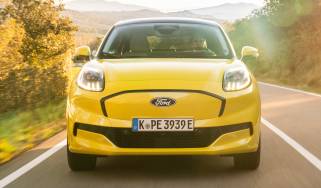Used Mercedes C-Class saloon review: 2014-2021 (Mk4) - Engines, drive and performance
Comfortable suspension and spirited, economical engines contribute to a sense of easy-going refinement to travelling by C-Class Mk4
Combine the AMG Line’s racy styling and sports suspension with some of the higher-powered engines, and you’ve got the bones of a fine sporting saloon, Yet the underlying characteristics of most versions of the C-Class Mk4 mean that relaxation is the order of the day. Its engines are, on the whole, refined, easy performers, and levels of engine, tyre and wind noise inside the cabin are well suppressed.
The steering of the C-Class Mk4 isn’t as sharp and precise as that of some rivals, and while you might initially wish it wasn’t so light, it doesn’t take long to get used to. The ‘comfort’ suspension of the SE trim grade is exactly as advertised; supple yet keeping the car from rolling excessively through bends. The lowered set-up of the Sport models adds a little more precision to handling without spoiling the comfortable ride.
AMG Line suspension also adds firmer dampers to the lowered suspension, making the ride a little stiffer than the other models. Even so, it’s best to take an AMG Line car on an extended test drive to make sure it’s comfortable enough for your needs.
Which engine should I choose?
The best-of-all-worlds engine choice is the 191bhp 2.0-litre twin-turbo diesel you’ll find beneath the bonnet of post-2018 C220d facelift models. Not only is it quick in a straight line – 0-62mph in 6.9 seconds – the peak of its pulling power, or torque (400Nm) is available at just 1,600rpm, meaning you have lots of instant muscle at your disposal for safer overtaking. Furthermore, because this is a post-revamp C-Class Mk4, this engine is mated to an excellent nine-speed automatic gearbox. Fuel economy of up to 61.4mpg seals the deal.
More reviews
Of course, the post-revamp models may be beyond your budget, so the earlier version of the C220d is a fine alternative. It’s a 2.1-litre diesel with a single turbocharger, and although it’s less powerful (168bhp) and not as refined, it has the same amount of pulling power and provides similar levels of performance and fuel economy.
If diesel isn’t your thing, try the mild hybrid EQ Boost 1.5-litre turbocharged petrol that’s badged C200 on post-facelift models. With a combined 195bhp from its combination of conventional engine and small electric motor, it’ll race from 0-62mph in 7.7 seconds. But the impressive part of its performance stems from the fact that the electric motor boosts muscle from very low engine revs, which makes a big difference to the way you can nip around in traffic or when you’re overtaking. It’s also quiet, even when worked hard, and returns up to 47.1mpg.
While those are our top engine choices, you can’t really go wrong with most of the engines from the C-Class Mk4’s range. Even the turbocharged 1.6-litre diesel and petrol engines in the C200d and C180 have adequate performance and fuel efficiency, while the diesel C250d and C300d, together with the petrol C300, are extremely rapid while not being too heavy on fuel. Those two diesels, though, can be a bit gruff at high revs and loud enough to intrude upon the peace of the cabin, yet they have so much accessible pulling power that you seldom need to drive them in such a manner.
The 2.1-litre twin-turbo diesel and small electric motor combo in the mild hybrid C300 BlueTEC Hybrid is also a gutsy performer thanks to the boost the electric motor provides from very low engine revs. It’s a star at the fuel pumps, too, with its Combined 78.4mpg. The only trouble is that it doesn’t really offer enough of a performance or efficiency edge over the conventional diesel models to justify the extra expense of buying it.
When the diesel-electric C300de and petrol-electric C350e plug-in hybrids were exempt from the London Congestion Charge, their high prices could be offset against the daily savings you made driving around the capital. That advantage is now denied them, sadly. Still, being able to drive up to 35 miles on electric power means they’re a great choice if you commute a relatively short distance to the office, or make lots of short hops from home. If you recharge the battery frequently, then these machines can deliver some significant fuel savings.















